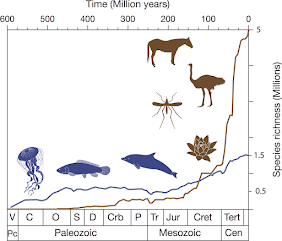- Get link
- X
- Other Apps
Biodiversity Conservation in Earth and Planetary Sciences
Biodiversity is essential for the stability and resilience of ecosystems, providing a wide range of services that are vital to human survival and well-being. The fields of Earth and planetary sciences play a crucial role in understanding and conserving this biodiversity. By integrating knowledge from geology, ecology, climatology, and other scientific disciplines, researchers can develop effective strategies to address biodiversity loss caused by human activities and environmental changes.
Understanding Biodiversity through Geological History
Climate Change Impacts
Climate change is one of the most significant threats to biodiversity today. Earth and planetary sciences offer vital tools for assessing how climate shifts impact ecosystems. By analyzing historical climate data and modeling future scenarios, scientists can identify vulnerable species and habitats. This knowledge enables conservationists to prioritize areas for protection and develop strategies to mitigate the impacts of climate change on biodiversity. For instance, creating wildlife corridors can help species migrate to more suitable habitats as temperatures rise, ensuring their survival.
Ecosystem Services and Sustainability
The concept of ecosystem services highlights the benefits that biodiversity provides to human societies, including clean air and water, pollination of crops, and climate regulation. Earth sciences inform our understanding of these services by illustrating how geological and ecological processes interact. For example, healthy wetlands can filter pollutants and provide flood protection, while forests sequester carbon and support diverse species. By integrating ecosystem services into land-use planning and policy-making, stakeholders can make informed decisions that promote sustainable practices while conserving biodiversity.
Technological Advances in Conservation
Advancements in technology, such as remote sensing and Geographic Information Systems (GIS), have revolutionized biodiversity conservation efforts. These tools allow researchers to monitor changes in land use, habitat loss, and species distributions on a global scale. By mapping critical habitats and assessing threats, conservationists can develop targeted interventions that are both efficient and effective. For example, satellite imagery can track deforestation in real time, enabling timely action to protect endangered ecosystems.
Policy and Education
Effective biodiversity conservation also requires strong policy frameworks and public engagement. Earth and planetary sciences can inform policy by providing evidence-based data on biodiversity status and trends. Additionally, educating the public about the importance of biodiversity and the role of Earth sciences fosters a culture of conservation. Community involvement in conservation initiatives enhances the likelihood of success, as local populations are often the best stewards of their natural environments.
Conclusion
In conclusion, the integration of biodiversity conservation with Earth and planetary sciences is essential for addressing the multifaceted challenges facing the natural world today. By leveraging interdisciplinary knowledge, scientists and policymakers can develop innovative strategies that not only protect biodiversity but also enhance the resilience of ecosystems. As we move forward, a collaborative approach that includes scientific research, community engagement, and sustainable practices will be critical in preserving the planet’s rich biodiversity for future generations.
"International Academic Achievements and Awards"
Visit our website : https://academicachievements.org/
To Contact us: contact@academicachievements.org
Awards Nominate : https://academicachievements.org/award-nomination/?ecategory=Awards&rcategory=Awardee
Get Connected Here:
Facebook : https://www.facebook.com/profile.php?id=100092743040677
Twitter : https://x.com/VineetaSingh28
Instagram : https://www.instagram.com/vineetasingh027/?hl=en
YouTube : https://www.youtube.com/@AcademicAchievements
- Get link
- X
- Other Apps





Comments
Post a Comment